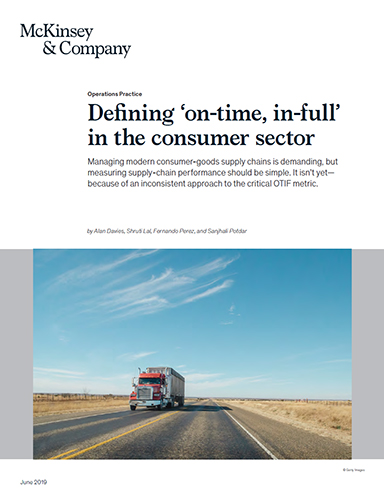Defining ‘On-Time, In-Full’ In the Consumer Sector
Managing modern consumer-goods supply chains is demanding, but measuring supply-chain performance should be simple, it isn’t yet, because of an inconsistent approach to the critical OTIF metric.
Consumers Expect Products to be on the Shelf
The US food retail industry loses an estimated $15-20 billion in sales every year because items are out of stock or otherwise unsaleable.
That’s around two to three percent of its total sales.
The main operational challenge for the consumer sector is to achieve high levels of on-shelf availability, while keeping supply chain costs down and inventories under control.
Those objectives are getting harder to achieve. Supply-chain complexity is rising as customers demand a wider selection of products, a broader choice of channels, and more promotional offers.
With expectations of higher on-shelf availability and lower inventory costs, the pressure on delivery performance has intensified - as has the need for manufacturers, retailers, and carriers to work together to create efficient, reliable, and responsive supply chains.
In its effort to optimize its supply chains, the consumer industry has evolved in the way it measures delivery performance, moving away from the traditional “case-fill rate” and adopting the more rigorous “on-time in-full” (OTIF) delivery metric. OTIF measures the extent to which shipments are delivered to their destination according to both the quantity and schedule specified on the order. In theory, OTIF should be the ideal mechanism to align the objectives of retailers and manufacturers.
In practice, however, there is no standard definition for OTIF, so different supply-chain participants may interpret the metric in significantly different ways. Does “on-time” mean on the date requested by the retailer, or the date promised by the manufacturer? Does it mean within the specific delivery slot allocated to the shipment, or any time inside a broader, agreed-upon time window? Should “in-full” be measured at the level of complete orders, line-items or individual cases?
These differences matter. Effective supply-chain collaboration depends upon a precise, common understanding of delivery-performance expectations. Today’s diversity of approaches means partners waste time arguing over the figures, rather than addressing the root causes of delivery issues.
There’s already some evidence that attempts to avoid late-delivery penalties may be driving inefficiencies in manufacturer and retailer supply-chain operations. For example, about 25 percent of deliveries arrive more than two hours before their scheduled delivery appointment. Unloading those deliveries early can disrupt distribution-center operations, while holding trucks until their scheduled slot leaves assets standing idle, consuming industry capacity while incurring demurrage costs. By contrast, only 4 percent of shipments to retailers arrive more than 12 hours late, a delay that would be likely to hit on-shelf availability.
Understanding OTIF Expectations
To better understand industry perspectives on OTIF, the Trading Partner Alliance (TPA) and McKinsey surveyed 24 major retailers and manufacturers of consumer packaged goods operating in North America. Of those companies, 92 percent agreed that an industry standard for OTIF would create value.
They noted that a standard definition would significantly reduce discrepancies and confusion and promote collaboration among trading partners. Collaboration would help partners resolve supply problems more efficiently and effectively - creating value for all supply-chain participants as well as for consumers.
Drawing upon the survey data and McKinsey’s expertise in this field, this paper looks at the basic requirements and nuances of a standard definition of OTIF and proposes a standard for consideration by industry participants.
This paper also shows how the OTIF metric can improve an individual company’s supply chain performance and, through increased collaboration, generate significant value across industry participants.
What’s Related




Favorites





